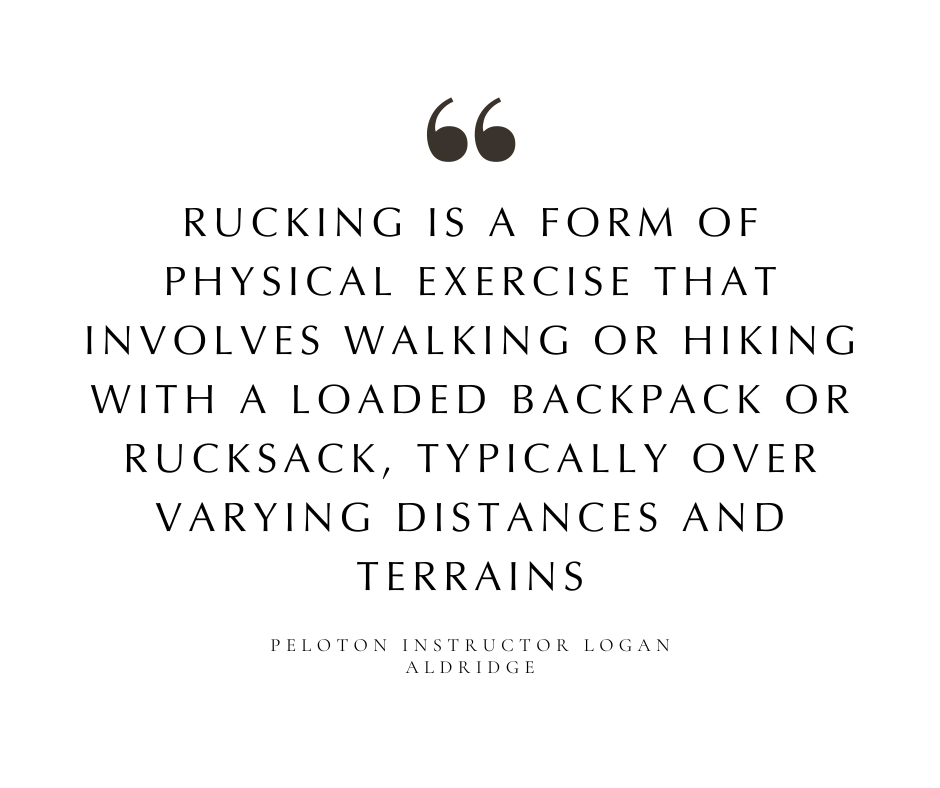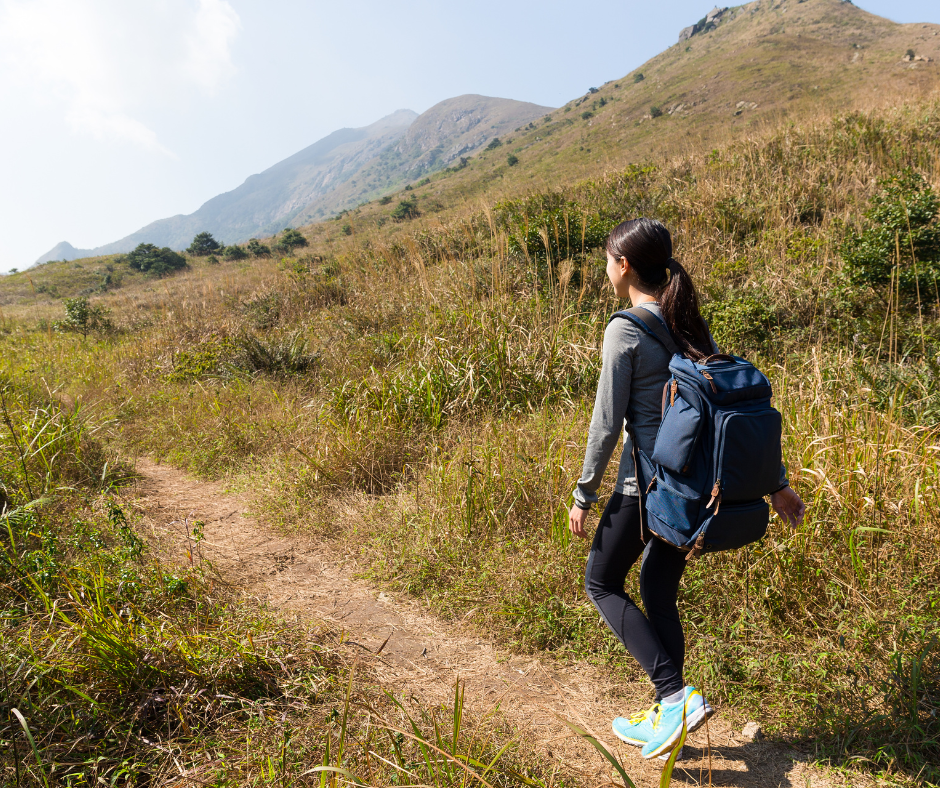

What is Rucking, and What Are the Benefits for Women?
Summary
Rucking is a beneficial exercise for women, offering a full-body workout that strengthens muscles, improves cardiovascular health, and reduces stress. Starting slowly with lighter weights and proper equipment is key to safety. Communicating plans and sharing locations with trusted contacts enhances security. Rucking is versatile, accessible, and cost-effective, making it suitable for women of all fitness levels to incorporate into their routines for a healthier lifestyle.
Reflection Questions
- How can you integrate rucking into your current fitness routine or lifestyle?
- What safety precautions will you take before embarking on your first rucking adventure?
- Are there any specific goals or areas of focus you have in mind for incorporating rucking into your fitness journey?
Journal Prompt
Reflect on your relationship with physical activity and outdoor exploration. Have you previously engaged in hiking, walking, or other forms of outdoor exercise? What aspects of these activities do you enjoy most, and what challenges, if any, have you encountered in maintaining a consistent routine? Consider how the inclusivity and accessibility of rucking, as described in the article, might align with your interests and goals for incorporating more physical activity into your life.
Another exercise craze or an important part of cardiovascular fitness with numerous mental health benefits? Originating as part of comprehensive military training programs, rucking is a form of exercise that involves walking or hiking while carrying weight from a backpack or rucksack. It engages various muscle groups throughout the body, including the legs, glutes, core, and upper body, leading to improved strength and endurance over time.
Women can benefit from rucking in several ways: it strengthens muscles, enhances cardiovascular health, improves the density of your bones (particularly important for women who are more prone to osteoporosis), reduces stress, promotes mental clarity and focus, boosts mood and self-esteem through the release of endorphins, provides a time-efficient workout option that can be done almost anywhere, offers a cost-effective exercise alternative, and allows for versatility in terrain and location. this makes rucking accessible and adaptable to individual preferences and fitness goals.
Overall, rucking offers women a holistic approach to fitness and well-being, combining physical activity, outdoor exploration, and mental rejuvenation. Let’s explore the benefits of rucking in further detail below.
What Exactly is Rucking?


Rucking or ruck marching is a form of exercise that involves weighted walking or hiking while carrying a weighted backpack, wearing a weighted vest, or opting for a rucksack. It’s essentially a type of weight training. Unlike traditional walking, which typically involves no added weight beyond your own body weight, rucking adds resistance by incorporating a weighted backpack. The weight can vary depending on individual fitness levels and goals but commonly ranges from 10 to 30 pounds or more. In some cases, weight plates are added to your loaded pack, but a rucking workout can be done with a pack containing essentials too.
As you walk with the added weight, your body must work harder to maintain balance and stability, engaging various muscle groups throughout the body, including the legs, glutes, core, and upper body. This increased resistance makes rucking an effective full-body workout that not only improves cardiovascular health but also builds strength, endurance, and muscle tone.
How Rucking Differs from Traditional Walking or Hiking


As personal trainers like Peloton instructor Logan Aldridge notes in the quote above, rucking differs from traditional walking or hiking primarily in the added weight and resistance provided by the backpack. While walking or hiking without added weight primarily targets cardiovascular fitness and lower body strength, rucking adds an additional challenge by requiring the upper body and core muscles to support and stabilize the weight of the backpack.
This makes rucking a more comprehensive workout that engages multiple muscle groups simultaneously, providing greater benefits for strength, endurance, and overall fitness. Additionally, rucking can be done on a variety of terrains, including pavement, trails, or even beaches, making it a versatile exercise option that can be adapted to different environments and fitness levels.
Equipment Needed for Rucking
The main piece of equipment needed for rucking is a sturdy backpack or rucksack capable of holding extra weight securely and distributing it evenly across the body. When choosing a backpack for rucking, look for one with padded shoulder straps and a waist belt to provide added support and comfort, especially during longer rucks. It’s important to ensure the backpack fits properly and is adjustable to accommodate different body sizes and shapes.
Additionally, consider the capacity of the backpack and choose one that can hold the desired amount of weight without becoming overly bulky or cumbersome. Apart from the backpack, wearing comfortable, supportive shoes with good traction is also essential for rucking, especially when walking on uneven terrain. Optional equipment for rucking may include trekking poles for added stability and hydration packs or water bottles to stay hydrated during longer rucks.
Overall, the equipment needed for rucking is relatively simple and accessible, making it an easy and affordable exercise option for individuals of all fitness levels.
How Much Weight Should I Carry as a Beginner?
When you start rucking, you should carry around 10-15% of your body weight. You can purchase weighted rucksacks or add weight to bags you already own. As you get more experienced, you can increase the weight to 20-25% of your body weight. Start light to avoid injury and gradually build up your endurance and strength.
Benefits of Rucking for Women


This approach to physical training offers numerous benefits for women. Rucking engages various muscle groups, including the legs, glutes, core, and upper body, as you carry the weight of the backpack or rucksack.
This can lead to improved muscle strength and endurance over time. Rucking can also help clear the mind and improve focus, allowing women to experience mental clarity and heightened concentration during and after the activity. Let’s explore the benefits in further detail.
Strengthens Muscles
Does rucking build muscle? Rucking engages various muscle groups throughout your body. As you carry the weight of the backpack or rucksack, your legs, including quadriceps, hamstrings, and calf muscles, work to support the load and propel you forward.
Additionally, the glutes are activated to stabilize the pelvis and hips, while the core muscles contract to maintain posture and balance. Even your upper body muscles, including the shoulders, arms, and back, are involved in stabilizing the weight and maintaining proper form. Over time, regular rucking can lead to improved muscle strength and endurance in these key muscle groups, enhancing overall physical performance and reducing the risk of injury.
Improves Cardiovascular Health


Rucking is a form of aerobic exercise that elevates your heart rate and increases oxygen consumption. This cardiovascular challenge helps to strengthen the heart muscle, improve circulation, and boost cardiovascular endurance.
As your heart and lungs work harder during rucking, they become more efficient at delivering oxygen-rich blood to the muscles and removing waste products, such as carbon dioxide. Over time, regular rucking can lead to improved cardiovascular health, increased stamina, and enhanced overall fitness levels, reducing the risk of heart disease and other cardiovascular conditions.
Enhances Bone Density
Rucking is a weight-bearing activity that subjects the bones to mechanical stress, which stimulates bone growth and remodeling. This is particularly beneficial for women, as they are more prone to osteoporosis and bone-related issues as they age.
The impact of carrying a weighted backpack or rucksack helps to strengthen bones and increase bone density, reducing the risk of fractures and osteoporosis. Regular rucking, combined with a balanced diet rich in calcium and vitamin D, can help maintain optimal bone health and reduce the risk of bone-related conditions later in life.
Fuel your creative fire & be a part of a supportive community that values how you love to live.
subscribe to our newsletter
*please check your Spam folder for the latest DesignDash Magazine issue immediately after subscription


Stress Reduction
Rucking provides an opportunity to escape the stresses of daily life and connect with nature. Being outdoors and engaging in physical activity can help reduce stress levels and promote relaxation. The rhythmic motion of walking combined with the sights and sounds of nature can have a calming effect on the mind, helping to alleviate stress and tension.
Additionally, the release of endorphins during exercise, also known as “feel-good” hormones, can enhance mood and promote a sense of well-being. Regular rucking can be an effective stress management tool, helping women to unwind, recharge, and improve overall mental well-being.
Mental Clarity and Focus


Rucking offers a break from the distractions of modern life and provides an opportunity to clear the mind and focus on the present moment. The repetitive nature of walking combined with the peaceful surroundings of nature can help quiet the mind and improve mental clarity and focus.
Many women find that rucking allows them to let go of worries and distractions, allowing them to concentrate more effectively on tasks and activities both during and after the activity. The sense of accomplishment and mental clarity gained from rucking can carry over into other areas of life, improving productivity and overall well-being.
Boosts Mood and Self-Esteem
Exercise, including rucking, stimulates the release of endorphins, neurotransmitters in the brain that act as natural mood lifters and pain relievers. The sense of accomplishment and satisfaction that comes from completing a ruck can boost mood and improve self-esteem.
Additionally, the physical improvements that result from regular rucking, such as increased strength and endurance, can enhance self-confidence and body image. As women experience the physical and mental benefits of rucking, they may develop a more positive outlook on life and feel more empowered to tackle challenges and pursue their goals.
Time-Efficient Workout Option
Rucking is a time-efficient way to get a full-body workout, as it combines cardiovascular exercise with strength training. Unlike some forms of exercise that require specialized equipment or a gym membership, rucking can be done almost anywhere with minimal equipment.
Whether you’re walking to work, hiking on a trail, or exploring a new city, you can easily incorporate rucking into your daily routine. Additionally, the intensity of your ruck can be easily adjusted by varying the weight of your backpack or rucksack, allowing you to tailor your workout to your fitness level and goals. With rucking, women can maximize their workout time and achieve significant health benefits in less time.
Cost-Effective Exercise


Compared to some other forms of exercise, such as joining a gym or purchasing expensive equipment, rucking is relatively affordable. All you need is a sturdy backpack or rucksack and some weight to get started.
Unlike gym memberships or fitness classes, which can involve monthly fees or upfront costs, rucking can be done for free or at minimal cost. Additionally, the equipment required for rucking, such as a backpack or rucksack, is durable and long-lasting, making it a cost-effective investment in your health and fitness.
Versatility in Terrain and Location
Rucking can be done on various types of terrain, including trails, sidewalks, or even on the beach. This versatility allows women to customize their rucking experience based on their preferences and fitness goals. Whether you prefer the peaceful solitude of a nature trail or the bustling energy of an urban environment, you can tailor your ruck to suit your mood and surroundings.
Additionally, rucking can be done year-round in almost any weather conditions, allowing women to stay active and connected to nature throughout the seasons. With rucking, women have the flexibility to explore new places, challenge themselves physically, and enjoy the outdoors in a way that fits their lifestyle and preferences.
Our Top Tips for Rucking Safely as a Woman
To ensure safety while rucking, women should prioritize several key practices. First, starting slowly with lighter weights and shorter distances allows the body to adapt gradually, reducing the risk of strain or injury. Choosing a properly fitted backpack with padded straps and a waist belt helps distribute weight evenly and minimizes strain on the back and shoulders.
Additionally, packing the backpack evenly and maintaining proper form while rucking further reduces the risk of discomfort or injury. Wearing proper footwear with good traction and staying hydrated are crucial for preventing slips, falls, and dehydration, especially on uneven terrain or during longer rucks.
Women should also listen to their bodies, taking breaks as needed and stopping if they experience any pain or discomfort. Being mindful of the terrain, using trekking poles for stability if necessary, and making oneself visible with reflective clothing or gear can further enhance safety while rucking. Overall, prioritizing these safety measures allows women to enjoy the physical and mental benefits of rucking while minimizing the risk of injury. Let’s delve a bit deeper into these best practices.
Start Slowly


Beginning with lighter weights and shorter distances allows your body to adapt gradually to the demands of rucking. This approach helps prevent overexertion and reduces the risk of injury. As your strength and endurance improve, you can gradually increase the weight of your backpack and the distance of your rucks, allowing for steady progress and minimizing the likelihood of strain or fatigue.
Choose the Right Backpack & Pack Properly
Investing in a sturdy backpack or rucksack is crucial for rucking safely and comfortably. Look for a backpack that distributes weight evenly across your back and shoulders to minimize strain. Padded shoulder straps and a waist belt provide additional support and help distribute weight more effectively, reducing pressure points and discomfort during longer rucks.
Ensuring the backpack fits properly is essential for stability and preventing shifting of the weight, which can lead to imbalance and strain.
Proper packing of your backpack is essential for maintaining balance and preventing strain on your back and shoulders. Distribute the weight evenly throughout the backpack, placing heavier items closer to your back and lighter items towards the outside.
This helps maintain stability and reduces the risk of discomfort or injury. Avoid overloading your backpack with unnecessary items, as this can increase strain and fatigue during your ruck.
Wear Comfortable Shoes & Maintain Proper Form


Choosing the right footwear is essential for preventing slips, falls, and foot discomfort while rucking. Opt for supportive, comfortable shoes with good traction to provide stability and reduce the risk of injury, especially when rucking on uneven or slippery terrain. Properly fitting shoes that offer ample support and cushioning help absorb impact and reduce strain on your feet, ankles, and knees, enhancing comfort and minimizing the risk of injury during your ruck.
Maintaining proper form while rucking is essential for preventing strain on your spine and muscles. Keep your back straight and shoulders back to distribute weight evenly and minimize stress on your spine.
Engage your core muscles to provide stability and support, reducing the risk of injury and improving posture. Regularly check your form throughout your ruck to ensure proper alignment and prevent slouching or leaning, which can increase strain on your back and shoulders.
Stay Hydrated
Staying hydrated is crucial for maintaining performance and preventing dehydration during rucking. Drink plenty of water before, during, and after your ruck to replenish fluids lost through sweating and maintain proper hydration levels.
Pay attention to your body’s thirst cues and drink water regularly, especially on hot days or during longer rucks. Dehydration can impair physical performance and increase the risk of heat-related illnesses, so staying hydrated is essential for rucking safely and effectively.
Listen to Your Body
Paying attention to your body’s signals is essential for preventing injury and promoting overall well-being during rucking. If you experience any signs of discomfort or pain, such as sharp pains, muscle cramps, or joint stiffness, stop and rest immediately.
Pushing through pain or discomfort can exacerbate injuries and lead to more serious issues. Listen to your body’s limits and adjust your ruck accordingly, taking breaks as needed and seeking medical attention if necessary.
Warm-Up and Cool Down
Warming up before your ruck and cooling down afterward helps prepare your body for exercise and promotes recovery. Start with dynamic stretches or a brisk walk to increase blood flow to your muscles and prepare them for the demands of rucking.
After your ruck, incorporate static stretches to improve flexibility and reduce muscle stiffness and soreness. A proper warm-up and cool down routine can help prevent injury and enhance overall performance during your ruck.
Be Mindful of Terrain


Being mindful of the terrain you’re rucking on is essential for preventing slips, falls, and other accidents. Be cautious when rucking on uneven or challenging terrain, such as steep hills or rocky trails. Take your time, watch your footing, and use trekking poles if necessary for added stability and support.
Adjust your pace and technique based on the terrain to maintain balance and reduce the risk of injury. Being aware of your surroundings and potential hazards helps ensure a safe and enjoyable rucking experience.
Be Visible
If you’re rucking near roads or in low-light conditions, you must make yourself visible to drivers and other pedestrians. Wear bright, reflective clothing and use a headlamp or flashlight to increase visibility and safety, especially during early morning or evening rucks.
Making yourself visible reduces the risk of accidents and ensures that others can see you, helping to prevent collisions and promote safety during your ruck.
Share Your Location with a Trusted Friend or Family Member
Informing a trusted friend or family member about your rucking plans and providing access to your location can significantly enhance safety. This precaution ensures that someone knows your whereabouts in case of an emergency and can provide assistance if needed. Sharing details such as the route you plan to take, expected duration of your ruck, and your estimated return time can help loved ones keep track of your progress and respond promptly if necessary.
Many mobile devices offer features like location sharing or real-time tracking that allow others to monitor your movements remotely, providing an added layer of security during your ruck. By communicating with trusted individuals and enabling access to your location, women can enjoy peace of mind while rucking, knowing that help is readily available if needed.
Final Thoughts on Adding Rucking to Your Exercise Regimen


Rucking offers women a unique and rewarding approach to fitness that encompasses physical activity, outdoor exploration, and mental rejuvenation. Through engaging multiple muscle groups and providing a full-body workout, rucking strengthens muscles, improves cardiovascular health, and enhances overall well-being. With its accessibility, versatility, and affordability, rucking accommodates diverse fitness levels and preferences, empowering women to pursue their fitness goals at their own pace and in their preferred environment.
By prioritizing safety measures such as starting slowly, choosing the right equipment, and staying connected with trusted individuals, women can enjoy the many benefits of rucking while minimizing the risk of injury. Whether exploring local trails, commuting to work, or embarking on outdoor adventures, rucking offers women an opportunity to embrace a healthier, more active lifestyle while connecting with nature and achieving their fitness aspirations.








